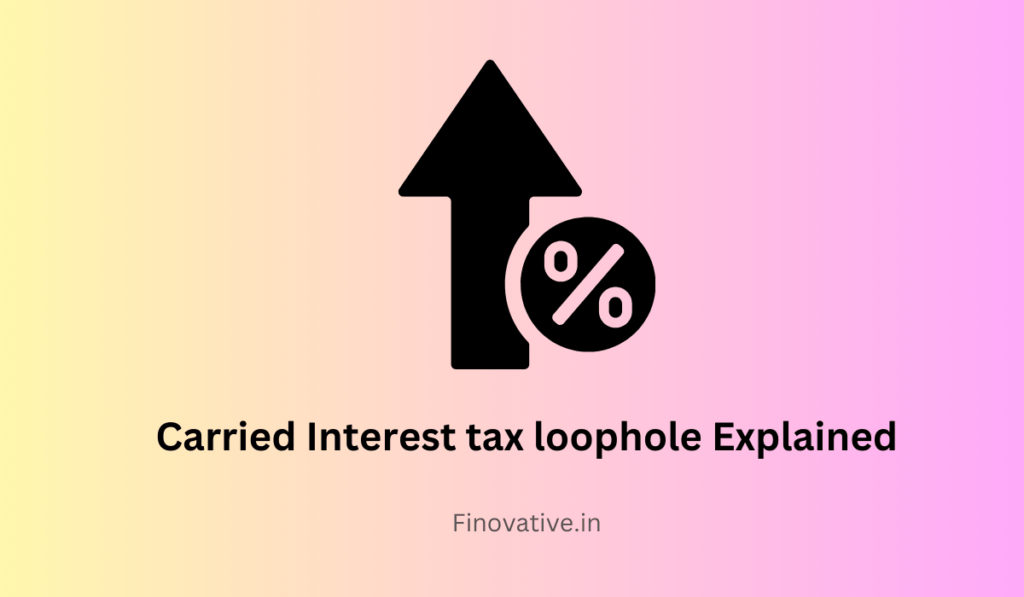The carried interest tax loophole has been a considerable debate and controversy in finance and taxation. It is often discussed in the context of private equity, venture capital, and hedge funds. This tax provision has allowed investment managers to pay lower tax rates on their earnings, sparking discussions about fairness and equity in the tax code. In this comprehensive guide, we will explore the carried interest tax loophole, explain how it works, discuss its implications, and examine the arguments from both sides of the debate.
Understanding Carried Interest
Before delving into the tax loophole, it’s crucial to understand what carried interest is and why it matters:
Carried Interest Definition: Carried interest, commonly referred to as “carry,” is a share of the profits earned by an investment fund that is allocated to the fund’s managers, often called general partners. It serves as a performance-based incentive, aligning the interests of fund managers with those of the investors in the fund.
Purpose of Carried Interest: Carried interest motivates investment professionals to make strategic investment decisions and actively manage the fund to maximize returns for investors. It rewards managers for their expertise and success in generating profits.
The Carried Interest Tax Loophole
The controversy surrounding carried interest centers on the tax treatment of this form of compensation. Under the current U.S. tax code, carried interest is often classified as a long-term capital gain, which carries a lower tax rate compared to ordinary income. This tax treatment is the heart of the carried interest tax loophole.
How the Loophole Works
- Capital Gains Tax Rate: Long-term capital gains, such as those generated from the sale of investments held for more than one year, are subject to a lower tax rate. In the United States, as of my last knowledge update in September 2021, this rate can be as low as 0% for some taxpayers but generally ranges from 15% to 20%.
- Ordinary Income Tax Rate: On the other hand, ordinary income, which includes wages and salaries, is taxed at higher rates. The top marginal tax rate for ordinary income can exceed 35% or even 37%, depending on the taxpayer’s income level.
- Carried Interest Classification: Carried interest, despite being a share of profits earned through managing investments, is often classified as a long-term capital gain for tax purposes. This means that investment managers may pay the lower capital gains tax rate on their carried interest earnings.
The Implication
The carried interest tax loophole allows investment managers to benefit from the lower capital gains tax rate on what is essentially performance-based compensation. Critics argue that this tax treatment results in a significant reduction in the tax liabilities of investment managers, leading to lower overall tax revenue for the government.
Arguments in Favor of the Carried Interest Tax Loophole
Proponents of the carried interest tax treatment argue that it has several valid justifications:
1. Encouraging Investment
The lower tax rate on capital gains is designed to incentivize investment in the economy. By allowing investment managers to benefit from this rate, it encourages them to invest in potentially high-growth ventures, supporting economic growth and job creation.
2. Aligning Interests
Carried interest aligns the interests of investment managers with those of the fund’s investors. By allowing managers to share in the fund’s profits, it ensures that they are motivated to make sound investment decisions that yield positive returns.
3. Risk and Reward
Investment managers often assume significant risks in their roles. They may not receive any carried interest if the fund underperforms or fails to surpass the hurdle rate. Therefore, the lower tax rate on carried interest can be seen as a reward for taking on this risk.
Arguments Against the Carried Interest Tax Loophole
Critics of the carried interest tax loophole raise several concerns:
1. Unfair Taxation
One of the primary criticisms is that the current tax treatment of carried interest is unfair. Critics argue that it allows wealthy investment managers to pay lower tax rates on their earnings compared to individuals with similar income levels who earn ordinary wages and salaries.
2. Income Inequality
The loophole has been cited as contributing to income inequality. By allowing investment managers to pay lower taxes on their substantial earnings, it exacerbates disparities in wealth and income.
3. Revenue Loss
The U.S. government loses significant tax revenue due to the carried interest tax treatment. Critics argue that closing this loophole could provide additional revenue that could be used for important public services and programs.
Legislative Efforts to Address the Issue
Over the years, there have been several legislative efforts to change the tax treatment of carried interest. These efforts have aimed to:
1. Reclassify Carried Interest
Some proposed legislation seeks to reclassify carried interest as ordinary income rather than capital gains. This would subject investment managers to higher tax rates on their earnings.
2. Increase Holding Period
Other proposals have suggested increasing the minimum holding period for investments to qualify for the lower capital gains tax rate. This change would impact the timing of taxation for carried interest.
3. Implement Minimum Income Thresholds
Certain legislative proposals have advocated for the implementation of minimum income thresholds for individuals benefiting from the carried interest tax treatment. Those below the threshold would continue to pay the lower tax rate, while those above it would be subject to higher rates.
The Debate Continues
The debate over the carried interest tax loophole remains a contentious issue in the world of finance and taxation. Proponents argue that the current tax treatment incentivizes investment and aligns the interests of managers with those of investors. Critics, however, contend that it leads to unfair taxation, income inequality, and revenue loss for the government.
The resolution of this issue may require a careful balancing act that considers the potential impacts on investment incentives, economic growth, and tax equity. As of my last knowledge update in September 2021, the tax treatment of carried interest had not undergone significant changes at the federal level in the United States. However, it’s important to note that tax policies can evolve, and future legislative changes could potentially address the carried interest tax loophole in one way or another.
Conclusion
The carried interest tax loophole is a complex and controversial topic that involves the taxation of compensation for investment managers in private equity, venture capital, and hedge funds. While proponents argue that it encourages investment and aligns interests, critics contend that it leads to unfair taxation and income inequality.
The debate surrounding this issue highlights the ongoing discussions and challenges related to tax policy, equity, and economic incentives. As the tax code evolves and legislative efforts continue, the future of the carried interest tax treatment remains uncertain, making it an important subject for those interested in finance, taxation, and economic policy.


